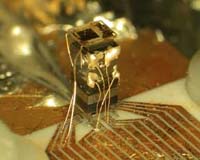 |
Houston TX (SPX) Sep 30, 2010 A Rice University-led team of physicists is reporting the first success in a three-year effort to build a precision simulator for superconductors using a grid of intersecting laser beams and ultracold atomic gas. The research appears this week in the journal Nature. Using lithium atoms cooled to within a few billionths of a degree of absolute zero and loaded into optical tubes, the researchers created a precise analog of a one-dimensional superconducting wire. Because the atoms in the experiment are so cold, they behave according to the same quantum mechanical rules that dictate how electrons behave. That means the lithium atoms can serve as stand-ins for electrons, and by trapping and holding the lithium atoms in beams of light, researchers can observe how electrons would behave in particular types of superconductors and other materials. "We can tune the spacing and interactions among these ultracold atoms with great precision, so much so that using the atoms to emulate exotic materials like superconductors can teach us some things we couldn't learn by studying the superconductors themselves," said study co-author Randy Hulet, a Rice physicist who's leading a team of physicists at Rice and six other universities under the Defense Advanced Research Projects Agency's (DARPA) Optical Lattice Emulator (OLE) program. In the Nature study, Hulet, Cornell University physicist Erich Mueller, Rice graduate students and postdoctoral researchers Yean-an Liao, Sophie Rittner, Tobias Paprotta, Wenhui Li and Gutherie Partridge and Cornell graduate student Stefan Baur created an emulator that allowed them to simultaneously examine superconductivity and magnetism - phenomena that do not generally coexist. Superconductivity occurs when electrons flow in a material without the friction that causes electrical resistance. Superconductivity usually happens at very low temperatures when pairs of electrons join together in a dance that lets them avoid the subatomic bumps that cause friction. Magnetism derives from one of the basic properties of all electrons - the fact that they rotate around their own axis. This property, which is called "spin," is inherent; like the color of someone's eyes, it never changes. Electron spin also comes in only two orientations, up or down, and magnetic materials are those where the number of electrons with up spins differs from the number with down spins, leaving a "net magnetic moment." "Generally, magnetism destroys superconductivity because changing the relative number of up and down spins disrupts the basic mechanism of superconductivity," Hulet said. "But in 1964, a group of physicists predicted that a magnetic superconductor could be formed under an exotic set of circumstances where a net magnetic moment arose out of a periodic pattern of excess spins and pairs." Dubbed the "FFLO" state in honor of the theorists who proposed it - Fulde, Ferrell, Larkin and Ovchinnikov - this state of matter has defied conclusive experimental observation for 46 years. Hulet said the new study paves the way for direct observation of the FFLO state. "The evidence that we've gathered meets the criteria of the FFLO state, but we can't say for certain that we have observed it. To do that, we need to precisely measure the distribution of velocities of the pairs to confirm that they follow the FFLO relationship. We're working on that now."
Share This Article With Planet Earth
Related Links Rice University Understanding Time and Space
 'Tabletop' science confirms relativity
'Tabletop' science confirms relativityBoulder, Colo. (UPI) Sep 23, 2010 Exploring the peculiar effects of Einstein's relativity theory is no longer rocket science - in fact, U.S. scientists say it can be demonstrated on a tabletop. Using super precise atomic clocks, scientists have witnessed the phenomenon of time dilation - the bizarre speeding up or slowing down of time described by the theory, ScienceNews.org reported. "Modern technology has got ... read more |
|
| The content herein, unless otherwise known to be public domain, are Copyright 1995-2010 - SpaceDaily. AFP and UPI Wire Stories are copyright Agence France-Presse and United Press International. ESA Portal Reports are copyright European Space Agency. All NASA sourced material is public domain. Additional copyrights may apply in whole or part to other bona fide parties. Advertising does not imply endorsement,agreement or approval of any opinions, statements or information provided by SpaceDaily on any Web page published or hosted by SpaceDaily. Privacy Statement |